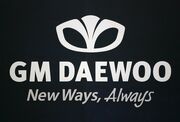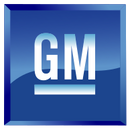| Type | Subsidiary of GM |
|---|---|
| Founded |
1937 (As Shinjin Industrial Co.) 2002 (GM Daewoo) 2011 (GM Korea) |
| Headquarters | Bupyeong-gu, Incheon, South Korea |
| Key people | President and CEO: Michael Arcamone |
| Industry | Automotive |
| Products |
Automobiles Consumer goods |
| Employees | 17,000 |
| Parent | General Motors |
| Website | GM Korea.kr |
| GM Korea | |
|---|---|
| Hangul | 한국GM |
| Revised Romanization | Hanguk GM |
| McCune–Reischauer | Hanguk GM |
| GM Korea | |
|---|---|
| Hangul | 지엠대우 |
| Revised Romanization | Jiem daeu |
| McCune–Reischauer | Jiem taeu |
GM Korea Company[1] (GM Daewoo Auto and Technology Company or GM DAT) is the third largest South-Korean automobile manufacturer, member and part of the General Motors Company.
GM Korea roots go back to the former Daewoo Group which went bankrupt in 1999. It has five manufacturing facilities in Korea as well as an assembly facility in Vietnam. In addition, GM Korea provides market and brand-specific vehicle kits for assembly at GM facilities in China, Thailand, India, Colombia and Venezuela. In 2008, GM Daewoo sold in Korea and exported more than 1.9 million units, including CKD products. GM Korea now produces vehicles and kits for Chevrolet, Opel/Vauxhall, Holden and Suzuki that are offered in more than 150 markets on six continents. On January 20, 2011, General Motors announced that GM Daewoo would be renamed GM Korea Co. "to reflect its heightened status in global operations of GM,"[2] effective March 2011. Most of the vehicles will be rechristened as Chevrolets, with plans for GM in South Korea to establish either Opel or Buick there.
History[]
- See also Saehan Motors and Daewoo Motors
GM Korea roots go back to the remnants of the Korean War and Shinjin Motor, which launched its business by rebuilding scrapped US military vehicles at its Bupyeong plant. Shinjin Motor's was first established as National Motor in 1937 in Bupyeong-gu, Incheon, South Korea. After changing its name to Saenara Motor in 1962, Saenara Motor was bought by Shinjin Industrial in 1965, which changed its name to Shinjin Motor after establishing collaborations with Toyota. After Toyota's withdrawal in 1972, Shinjin Motor changed its name to GM-Korea in 1972 with General Motors taking over a 50 per cent stake in the company from Toyota in 1972. but was renamed again in 1976 to Saehan Motor. Korea Development Bank (KDB), the company's creditor, took over management in 1976 as the company found itself unable to cope with competition from Hyundai Motor's popular Pony and Kia Motors' Brisas. After the Daewoo Group gained control in 1982 the name was changed to Daewoo Motor. In the early 1990s the company started to expand heavily throughout the world. Until 1996 all cars were based on models from General Motors. After the Asian financial crisis started in 1997, it took over the troubled SUV specialist SsangYong in 1998, but ran into financial trouble in 1999.
The establishment of GM Korea[]
In 2001 General Motors bought most of Daewoo Motor's assets to form GM Daewoo. The new company started operations on October 17, 2002, with GM and its partners Suzuki and SAIC holding a stake of 66.7% with investments of US$400 million. The GM holding was formally purchased by GM Holden Ltd which holds a seat on the board.[3] The remaining equity stake of 33.3% was held by Korea Development Bank and several other Korean creditors with investments of US$197 million. The deal did not include 15 plants, especially Daewoo's oldest plant in Bupyeong-gu which now operates under the name Daewoo Incheon Motor Company as a supplier to GM Daewoo. In 2004, Tata Motors purchased Daewoo's Truck manufacturing unit. In February 2005, GM invested US$49 million to raise its share in the company to 48.2%. In 2008, General Motors owned 50.9%, Suzuki 11.2 %, the Shanghai Automotive Industry Corporation 9.9 % and the Daewoo Motor Creditors Committee the remaining 28%.[4] In October 2009, GM increased its GMDAT holding; as of this date, GM is 70.1 percent owner, the Korean Development Bank holds 17 percent, Suzuki 6.8 percent and SAIC 6 percent.[5]
GM Korea has design, engineering, research & development facilities that are involved in development for various GM products, above all small-size cars. On November 25, 2003, the design center was relocated to the new 2-story building at the Bupyeong-gu headquarters.
The first car to be produced under the GM Daewoo nameplate was the 2002 Lacetti, replacing the Nubira. This car was developed under the Daewoo Motor era, but its fate became incredible, becoming GM's world car, sold under many different marques all around the globe. After a few years without real new car to present, GM Daewoo introduced in 2005 the Holden based Statesman luxury car replacing the discontinued Daewoo Chairman. The third generation of Matiz was introduced, refreshed by the GM Daewoo design team, and an evolution of the 4-door Kalos appeared : the Gentra.

GM Daewoo logo
In early 2006, GM Daewoo presented the L6 Magnus replacement, the Tosca. GM Daewoo's official press releases says that Tosca is an acronym for "Tomorrow Standard Car". The end of the same year, GM Daewoo introduced the Winstorm - its first proper SUV, which is, as the Lacetti, sold worldwide under different marques and names including Opel, Chevrolet, GMC, Holden or Saturn. It featured a common rail Diesel engine for the first time in a Daewoo vehicle, in addition to regular four and six cylinder gasoline engines. The diesel engine design is licensed from the Italian engine maker VM Motori.
2007 has seen the introduction of the wagon version of the Lacetti and Kalos hatchback's facelift, becoming Gentra X. For 2008, GM Daewoo introduced the first Korean roadster : the G2X sports car, a badge-engineered Saturn Sky, and started to sell the Opel Antara under the name of Winstorm MaXX. The Statesman flagship was also replaced by the new Veritas still on a Holden basis.
Late 2008 and early 2009 were a major period for GM Daewoo with the introduction of the all-new Lacetti Premiere, which is based the Chevrolet Cruze, a very important car for GM worldwide. The latest GM Korea product today is the all-new Chevrolet Spark, third generation of Matiz mini car.
GM Daewoo cars outside South Korea[]
Before GM’s buyout, Daewoo cars were available in different countries.

1997 J100 Daewoo Nubira
In Europe, Daewoo Motor started selling the Espero and Cielo-based Nexia early 1995. The range was then completed by the Lanos, Nubira and Leganza. The Matiz mini car was released in 1998, and was a great success for Daewoo, most notably in Italy where it won many awards such as the “Car of the Year” award three times in a row, in 1998, 1999 and 2000.[6]
The Rezzo (Tacuma), Evanda (Magnus) and Kalos models were then released, before the SsangYong-based SUVs : Korando, Musso and Rexton. After GM’s buyout, the Daewoo models got a new badge, and were sold under the Daewoo name till 2004 : the Nubira III (Lacetti) was the last car to wear a Daewoo badge in Europe.
Daewoo cars were also available in the US & Canada (1998–2002), Australia and many other countries, until Daewoo’s bankruptcy and GM’s buyout. Since Daewoo's withdrawal from many markets, the Lanos was moved to Chevrolet as the Aveo, whereas the Nubira and Leganza have been given replacements for either the Chevrolet or Suzuki brands.
January 1, 2005 saw the introduction of the Chevrolet brand in Europe, the whole Daewoo range being simply badge-engineered as Chevrolets. GM’s official tagline was that
“Daewoo has grown up enough to become Chevrolet.” [7]
and that this new name was an opportunity for Daewoo to become stronger. Unofficially, after Daewoo’s bankruptcy, former chairman Kim Woo-Choong’s escape and most notably the “Affaire Daewoo” in France (closure and conflagration of the Daewoo-Orion Electronics plant in Longwy, France),[8] the “Daewoo” brand name had a very bad image – so GM simply decided to extend the Chevrolet strategy that was already used in most other markets (Canada, India, Israel, Russia…) since 2003 to create a real global brand, replacing the Daewoo brand by the Chevy bowtie.
The Winstorm and Tosca were presented as Chevy Captiva and Epica. Some GM Daewoo cars changed names when rebadged, examples are the Matiz which became Chevrolet Spark in some markets (although Chevrolet Matiz was available too), or the Kalos which became Aveo (alongside Chevrolet Kalos in other countries). Today, the tendency goes towards a uniformisation in the Chevrolet Europe range : the Spark and Cruze will bear these names throughout the whole Europe.
GM Korea Manufacturing facilities[]
- Bupyeong-gu : vehicle assembly and gasoline/LPG engine manufacturing (production capacity: est. 440,000/year)
- Gunsan : vehicle assembly and diesel engine manufacturing (production capacity: est. 260,000/year)
- Changwon : vehicle assembly and gasoline/LPG engine manufacturing (production capacity: est. 210,000/year)
- Boryeong : transmission and engine components manufacturing
- Hanoi : VIDAMCO (Vietnam Daewoo Motor Co.) vehicle assembly (production capacity: est. 11,000/year)
Daewoo Motor emblems, slogans and logos[]

The Daewoo Royals emblem, on which was based the Royale Series logo.
Daewoo Motor emblems to be detailed here
- As a first logo, the cars had the "DAEWOO" Daewoo Group logo lettering.
- The Royale Series featured a crown-like logo, very similar to the Daewoo Royals football team logo.
- A "double D" logo was then used on the cars (as seen on Cielo, Espero, Brougham, Imperial...)
- Giugiaro redesigned this logo in 1994 (first seen on the Bucrane concept)
- On the European SUV line (Korando, Musso, Rexton), Daewoo Motor used a new version of this emblem, more squared. Later on, this logo was used by Daewoo Commercial Vehicle Co. Ltd (trucks), and Tata Daewoo.
- GM Daewoo emblem in 2002 : a modernized evolution of the Daewoo Motor logo.
- To be detailed : SsangYong-Daewoo logo, Statesman & Veritas hood ornament
- Slogans : UK 1995 "A different kind of car company? That'll be the Daewoo"
- "Daewoo, that's who"
- 2000 "Miraenun pakkemnida" : "Better future"
- 2002 "Driving innovation"
- 2008 "New ways, Always"
Daewoo Performance Automobiles[]
Daewoo Performance Automobiles was the performance car division of GM Daewoo. Like Holden's HSV and Opel's OPC, this company modified GM Daewoo models in South Korea and marketed them under the DPA brandname.
See also[]
- Chevrolet
- Daewoo Bus (not affiliated with GM Daewoo)
- Daewoo Motor Sales
- General Motors
- List of Daewoo models
- List of Korea-related topics
- List of Korean car makers
References[]
| This page uses some content from Wikipedia. The original article was at GM Korea. The list of authors can be seen in the page history. As with Tractor & Construction Plant Wiki, the text of Wikipedia is available under the Creative Commons by Attribution License and/or GNU Free Documentation License. Please check page history for when the original article was copied to Wikia |
- ↑ Formerly,Daewoo, is pronounced [tɛ.u] in Korean; The English pronunciation varies, but /ˈdaɪwuː/ is common.
- ↑ http://english.yonhapnews.co.kr/business/2011/01/20/33/0501000000AEN20110120004100320F.HTML
- ↑ http://awresearcher.net/VMSI/display.asp?vmsiid=2&contentid=12778
- ↑ [1][dead link]
- ↑ Tierney, Christine (2009-10-23). "GM takes larger stake in GM Daewoo". The Detroit News. Jonathan Wolman. Retrieved on 2009-10-26.
- ↑ "Matiz takes third Car of Year title in Europe " http://www.iol.co.za/index.php?set_id=4&click_id=132&art_id=iol987759180374M325
- ↑ FRENCH Official GM Daewoo/Chevrolet Magazine "Daewoo a pour ainsi dire, grandi pour devenir Chevrolet..."
- ↑ FRENCH http://archives.lesechos.fr/archives/2003/LesEchos/18832-95-ECH.htm
External links[]
- South Korea
| |||||
| ||||||||||||||||||||||||||||||||||||||||||||||||||||||||
| |||||||||||||||||
| |||||||||||
